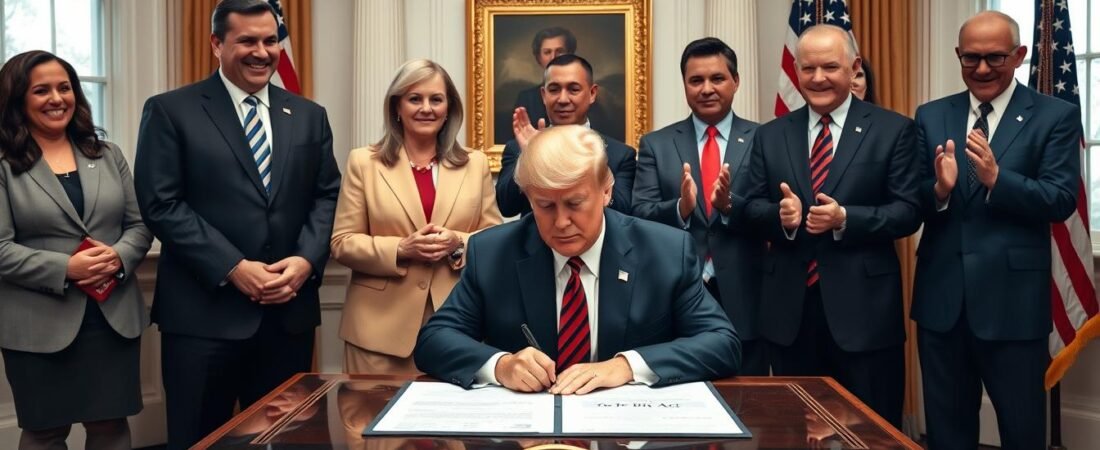President Donald Trump’s “One Big Beautiful Bill” has sent shockwaves through America’s clean energy sector. The sweeping legislation, which passed along party lines, represents the most significant shift in U.S. energy policy in decades. With provisions that slash renewable energy tax credits, phase out incentives for electric vehicles, and boost fossil fuel production, the bill has raised urgent questions about the future of clean energy in America.
The 887-page legislation extends Trump’s 2017 tax cuts while implementing steep cuts to Medicaid, food aid benefits, and critically for the energy sector, clean energy funding. As industry leaders, environmental advocates, and investors scramble to understand the full implications, one question looms large: Can America’s growing clean energy economy weather this political storm?
President Donald Trump signs the “One Big Beautiful Bill Act” at the White House, July 2025.
Stay Informed on Clean Energy Policy
Get weekly updates on how Trump’s Big Beautiful Bill affects clean energy markets, investments, and technologies. Our expert analysis helps you navigate the changing policy landscape.
Understanding Trump’s Big Beautiful Bill and Its Clean Energy Provisions
The “One Big Beautiful Bill Act,” as it was officially named before Senate procedural rules stripped the title, represents President Trump’s effort to consolidate his domestic agenda into a single piece of legislation. Passed with a narrow 218-214 vote in the House and a 51-50 vote in the Senate (with Vice President JD Vance breaking the tie), the bill makes sweeping changes to U.S. tax policy, government spending, and energy regulations.
The Congressional Budget Office projects the bill will increase the national debt by $3.3 trillion over a decade, with revenue losses of $4.5 trillion outstripping spending cuts of $1.2 trillion. But beyond the fiscal impact, the bill’s energy provisions signal a dramatic shift in federal policy toward renewable energy.
Key Clean Energy Provisions in the Bill
Tax Credit Eliminations
- Terminates $7,500 tax credit for new electric vehicles and $4,000 credit for used EVs by September 30, 2025
- Phases out Biden-era clean electricity production tax credits
- Eliminates tax incentives for energy-efficient home improvements
- Accelerates phaseout of solar and wind credits compared to other energy sources
Regulatory and Funding Changes
- Rescinds unspent funds from the Inflation Reduction Act’s clean energy programs
- Lowers oil and gas royalty rates on federal lands from 16.6% to 12.5%
- Reduces coal royalty rates from 12.5% to 7%
- Reinstates fossil fuel lease sales in the Arctic National Wildlife Refuge
- Eliminates the Environmental and Climate Justice Program
Speaker Mike Johnson celebrated the bill’s passage, stating: “Republicans in Congress have succeeded in our mission to enact President Trump’s America First agenda. And importantly, we did it in record time, so that the effects of this nation-shaping legislation can be felt by the American people as soon as possible.”
Meanwhile, House Minority Leader Hakeem Jeffries condemned the legislation during a record-breaking floor speech, calling it the “big, ugly bill, this disgusting abomination,” and accused Republicans of working through the night to pass it because it would kick millions of people off Medicaid and food stamps.

Clean energy workers review how new policy changes will affect ongoing solar projects.
Historical Context: How Trump’s Bill Compares to Previous Energy Policies
To understand the significance of Trump’s Big Beautiful Bill for clean energy, it’s helpful to place it in historical context. The legislation represents a dramatic pendulum swing from the Biden administration’s Inflation Reduction Act (IRA), which had been hailed as the most significant climate legislation in U.S. history.
| Administration | Major Legislation | Clean Energy Approach | Impact |
| Reagan (1981-1989) | Economic Recovery Tax Act | Cut renewable energy R&D by 85% | Slowed early solar and wind development |
| Bush (2001-2009) | Energy Policy Act of 2005 | Mixed: Added some renewables incentives while expanding fossil fuels | Modest growth in renewables alongside expanded drilling |
| Obama (2009-2017) | Recovery Act & Clean Power Plan | Major investments in renewables, efficiency standards | Accelerated solar/wind growth, coal decline |
| Biden (2021-2025) | Inflation Reduction Act | $369 billion for climate/clean energy | Triggered $132B in private clean energy investment |
| Trump (2025-) | One Big Beautiful Bill | Cuts clean energy incentives, boosts fossil fuels | Projected to add 470M tons CO2 annually by 2035 |
Amanda Levin, director of policy analysis at the Natural Resources Defense Council, called the bill “a massive hit to both our clean energy economy, the US economy as a whole, and to our future from a climate perspective.” The REPEAT Project from Princeton University projects the bill will contribute an additional 470 million metric tons of greenhouse gas emissions per year by 2035, equivalent to adding more than 100 million gas-powered cars to the road.
Unlike previous Republican administrations that maintained some support for renewable energy R&D or tax credits, Trump’s bill specifically targets and accelerates the phaseout of incentives for solar and wind compared to other energy sources. This approach differs even from Trump’s first term, when despite regulatory rollbacks, many clean energy tax credits remained intact.
Industry Impact: How Clean Energy Sectors Are Responding
The clean energy industry, which had been experiencing unprecedented growth under the Inflation Reduction Act, now faces significant headwinds. Different sectors within the clean energy economy are responding in various ways to the legislation’s provisions.
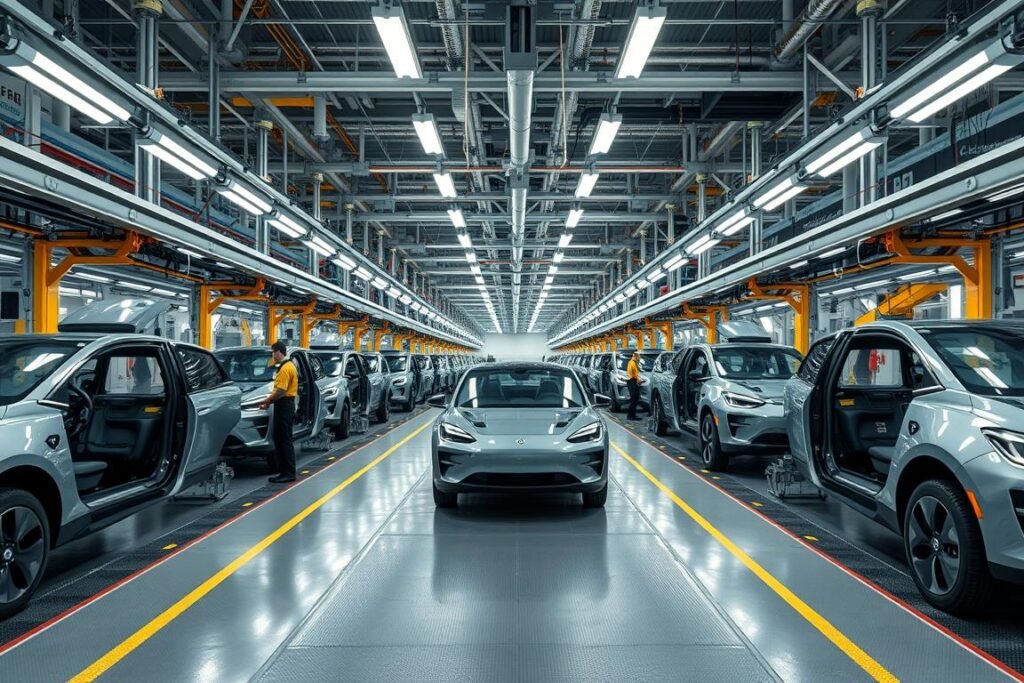
An electric vehicle manufacturing facility that may face production challenges following tax credit eliminations.
Electric Vehicle Market
The elimination of the $7,500 consumer tax credit for new electric vehicles and the $4,000 credit for used EVs by September 30 has created an immediate challenge for automakers. Industry analysts predict a summer of brisk EV sales as consumers rush to take advantage of the credits before they expire, followed by a significant sales decline.
Tesla, which had 10 of the 29 models eligible for the full tax credit, stands to lose the most. Despite CEO Elon Musk’s previous role in the Trump administration, he had urged lawmakers to reject the bill. Ford, General Motors, and other American automakers that had committed billions to EV manufacturing are now reassessing production targets.
“This creates tremendous uncertainty for automakers who made investment decisions based on the IRA’s long-term incentives,” said James Morton, auto industry analyst at Capital Research. “We’re likely to see production slowdowns and possible layoffs at EV plants across the country.”
Solar and Wind Industries
The solar and wind sectors face particularly harsh treatment under the bill, with their tax credits being phased out more quickly than other energy sources. The legislation also requires clean power projects to start using fewer Chinese-made components, which much of the industry heavily relies on.
Energy Innovation, a clean energy think tank, projects that job losses will reverberate for years, peaking at 900,000 by 2032, of which more than 230,000 would be manufacturing jobs. Solar installation companies that had been expanding rapidly are already announcing hiring freezes and project cancellations.
Download Our Comprehensive Analysis
Get our detailed 25-page report on how Trump’s Big Beautiful Bill affects different clean energy sectors, with state-by-state impact assessments and survival strategies for businesses.
State-Level Impacts
The bill’s effects will vary significantly by state, with some of the biggest impacts felt in states that had seen major clean energy investments under the IRA.
Texas
The nation’s leader in wind energy and a growing solar market faces significant challenges. The bill is expected to slow the expansion of the state’s renewable energy sector, which had been creating thousands of jobs annually. However, the state’s oil and gas industry will benefit from reduced royalty rates and expanded drilling opportunities.
Michigan
The auto manufacturing hub had attracted billions in EV and battery investments under the IRA. With EV tax credits eliminated, analysts project potential manufacturing job losses and plant construction delays. Governor Whitman has announced plans for state-level incentives to try to offset federal cuts.
California
The state with the most aggressive clean energy targets may be somewhat insulated from federal policy changes due to strong state mandates and incentives. However, the loss of federal tax credits will likely slow solar adoption and EV purchases. State officials have announced plans to expand California’s own clean energy incentives in response.
Perspectives: What Key Stakeholders Are Saying
The bill has generated strong reactions from across the political spectrum, with sharply divided opinions on its potential impact on clean energy and the broader economy.
Republican Perspectives
“This historic legislation will help usher in a new era of energy dominance by unlocking opportunities for investment, opening lease sales and expanding access to oil and natural gas development.”
“Republicans in Congress have succeeded in our mission to enact President Trump’s America First agenda. And importantly, we did it in record time, so that the effects of this nation-shaping legislation can be felt by the American people as soon as possible.”
“There could be no better birthday present for America than the phenomenal victory we achieved just hours ago when Congress passed the One Big Beautiful Bill to make America great again. This is a declaration of independence from a national decline.”
Democratic and Environmental Perspectives
“This is a full-scale assault on the air we breathe, the water we drink and the wild places we cherish. Republicans just opened the floodgates to turning some of our nation’s most beloved landscapes into sacrifice zones for polluter profits.”
“Workers will suffer from factory closures and construction halts. The bill moves to rescind unobligated funds that went to all these different types of grants to monitor pollution, improve local air quality and reduce public health risks.”
“We know that in the fight for clean air and clean water and a healthy environment that we can’t afford to stop fighting. So we’re going to keep doing that, and we know that the public is on our side.”
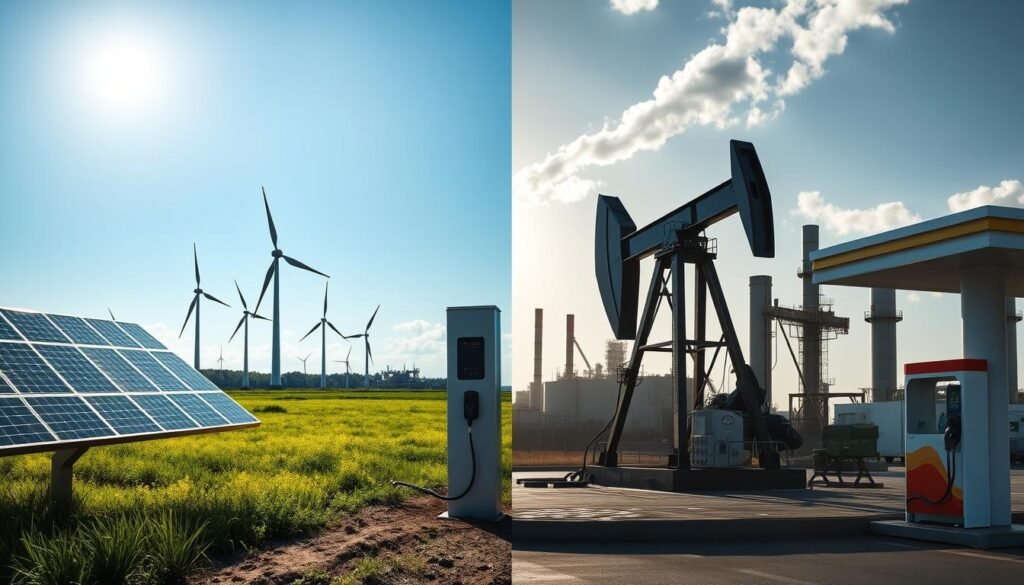
Economic Analysis
Economists remain divided on the bill’s long-term economic impact. Supporters argue that tax cuts will stimulate economic growth that will benefit all sectors, including eventually clean energy. Critics point to projected job losses in manufacturing and construction related to clean energy projects.
The Congressional Budget Office projects the bill will increase the national debt by $3.3 trillion over a decade. This could lead to higher interest rates, potentially making clean energy project financing more expensive in the future.
Potential Benefits
- Tax cuts may stimulate broader economic growth
- Reduced regulations could lower compliance costs
- Domestic fossil fuel production expansion may reduce energy prices
- Biofuel tax credits preserved for agricultural sector
- Increased farm subsidies may help rural communities
Potential Drawbacks
- Projected loss of up to 900,000 clean energy jobs by 2032
- Increased greenhouse gas emissions (470M tons annually by 2035)
- Potential manufacturing facility closures and construction halts
- Reduced air quality monitoring and environmental justice funding
- Higher debt may lead to increased interest rates for project financing
Survival Strategies: Can Clean Energy Thrive Despite Federal Changes?
Despite the challenging federal policy landscape, industry experts point to several factors that may help the clean energy sector weather the storm created by Trump’s Big Beautiful Bill.

Clean energy industry leaders discuss adaptation strategies following policy changes.
State and Local Policy Support
Many states have established their own renewable portfolio standards, clean energy incentives, and climate targets that will continue regardless of federal policy. California, New York, Massachusetts, and other states with Democratic leadership have already announced plans to expand state-level incentives to offset federal cuts.
“States have always been laboratories for clean energy policy,” said Sarah Lehman, energy policy director at the State Climate Alliance. “We expect to see many states step up with their own incentives and mandates to keep the clean energy transition moving forward.”
Corporate Commitments
Many major corporations have made commitments to reduce their carbon footprints and increase renewable energy use. These private sector drivers will continue to create demand for clean energy solutions regardless of federal incentives.
Companies like Amazon, Google, Microsoft, and Walmart have set ambitious renewable energy targets and may continue to drive market demand through power purchase agreements and other mechanisms. The RE100 initiative, which includes over 350 major companies committed to 100% renewable electricity, continues to grow.
Economic Fundamentals
Clean energy technologies have seen dramatic cost declines over the past decade, making them increasingly competitive with fossil fuels even without subsidies. Solar and wind are now the cheapest forms of new electricity generation in many markets.
“The economics of clean energy have fundamentally changed,” explained Michael Terrell, energy analyst at Goldman Sachs. “While the bill will certainly slow deployment, the long-term trend toward cheaper renewables will continue to drive market growth, albeit at a reduced pace.”
International Market Forces
Global momentum toward clean energy continues to accelerate, with major markets like the European Union, China, and India making significant investments. American companies that want to remain competitive in global markets will need to continue developing clean energy technologies and solutions.
The bill’s requirement for clean power projects to use fewer Chinese-made components presents both a challenge and an opportunity. While it may increase costs in the short term, it could accelerate domestic manufacturing of solar panels, wind turbines, and batteries.
Join Our Expert Webinar
Register for our upcoming webinar featuring energy policy experts from across the political spectrum discussing adaptation strategies for the clean energy sector under the new legislation.
Frequently Asked Questions About Trump’s Big Beautiful Bill and Clean Energy
How does Trump’s Big Beautiful Bill compare to his first term energy policies?
Trump’s current bill goes further than his first term policies in specifically targeting clean energy incentives. During his first term (2017-2021), Trump focused primarily on regulatory rollbacks and withdrew from the Paris Climate Agreement, but many clean energy tax credits remained intact. The current bill actively phases out these tax credits and creates new incentives for fossil fuels, representing a more aggressive approach to reshaping energy policy.
Which states will be most impacted by the clean energy provisions?
States that have seen the largest clean energy investments under the Inflation Reduction Act will likely feel the biggest impacts. These include Texas (wind and solar), Michigan and Georgia (EV and battery manufacturing), Nevada and Arizona (solar), and North Carolina (clean energy manufacturing). However, states with strong state-level clean energy policies like California, New York, and Massachusetts may be somewhat insulated from federal changes.
Will electricity prices increase or decrease as a result of the bill?
The impact on electricity prices is complex and will vary by region. In areas where utilities had been rapidly deploying low-cost renewables, the slowdown in deployment could result in higher electricity prices over time as utilities rely more on fossil fuels with volatile pricing. However, the bill’s support for domestic fossil fuel production could temporarily lower natural gas prices, potentially reducing electricity costs in the short term in some regions.
How will the bill affect jobs in the clean energy sector?
Analysis from Energy Innovation projects job losses that will peak at 900,000 by 2032, with more than 230,000 of those in manufacturing. The solar, wind, and electric vehicle sectors are expected to see the most significant job impacts. Some workers may find opportunities in traditional energy sectors that benefit from the bill, but the geographic distribution of these jobs will differ from clean energy jobs.
Can state policies effectively counteract the federal changes?
States have significant power to shape their energy markets through renewable portfolio standards, state tax incentives, and utility regulation. While state policies cannot fully replace federal tax credits in scale, states with strong clean energy commitments can partially offset federal changes. California, for example, has already announced plans to expand its clean vehicle rebate program in response to the federal EV tax credit elimination.
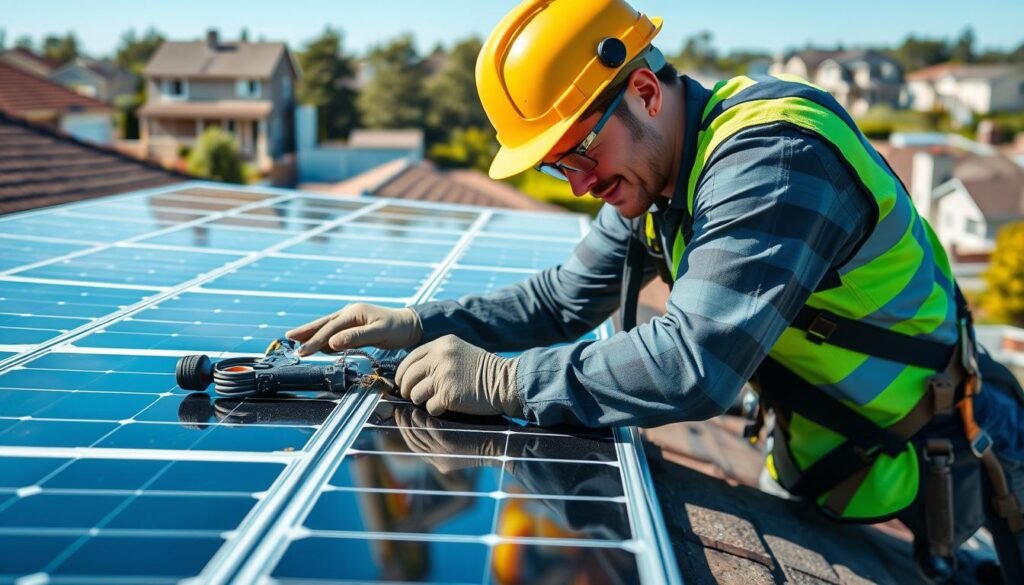
Residential solar installations may slow following the phaseout of tax incentives.
Conclusion: The Uncertain Future of Clean Energy Under Trump’s Bill
Trump’s Big Beautiful Bill represents a significant challenge to the clean energy sector that had been experiencing unprecedented growth under the Biden administration’s Inflation Reduction Act. The elimination of tax credits, phaseout of incentives, and boost to fossil fuel development will undoubtedly slow the pace of clean energy deployment and potentially lead to job losses across the solar, wind, and electric vehicle industries.
However, the clean energy transition has momentum beyond federal policy. State initiatives, corporate commitments, improving economics, and global market forces will continue to drive demand for renewable energy and clean technologies. The industry will likely experience a period of consolidation and adjustment rather than collapse.
As David Shadburn of the League of Conservation Voters noted, “We know that in the fight for clean air and clean water and a healthy environment that we can’t afford to stop fighting. So we’re going to keep doing that, and we know that the public is on our side.”
The coming years will reveal whether clean energy can maintain its growth trajectory despite the headwinds from federal policy changes, or whether Trump’s Big Beautiful Bill succeeds in fundamentally altering America’s energy future.
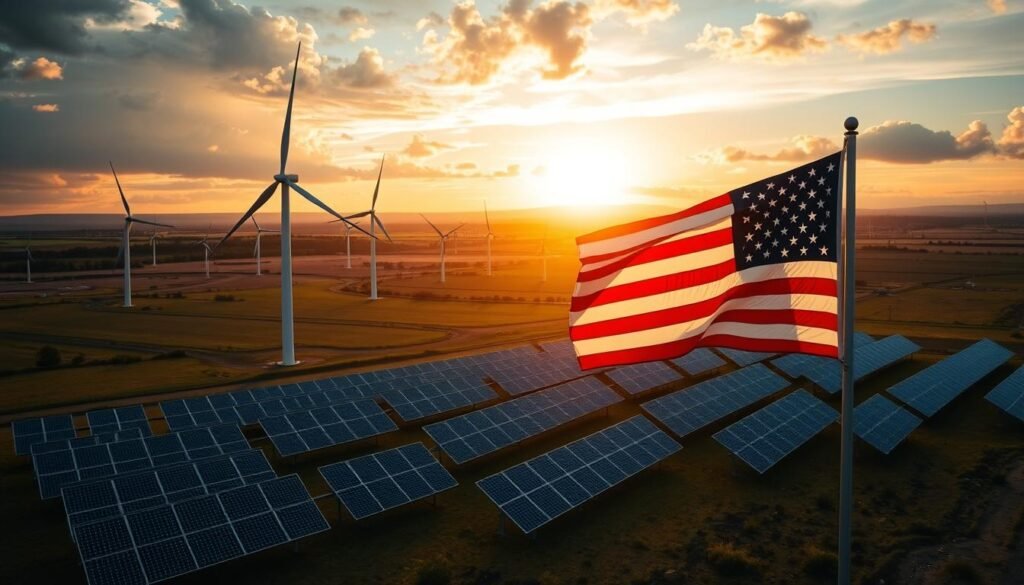
The future of American clean energy remains uncertain as policy shifts create new challenges.
Stay Informed on Clean Energy Policy
As the situation continues to evolve, stay updated with our expert analysis and reports on clean energy policy developments. Join thousands of industry professionals who rely on our insights.
